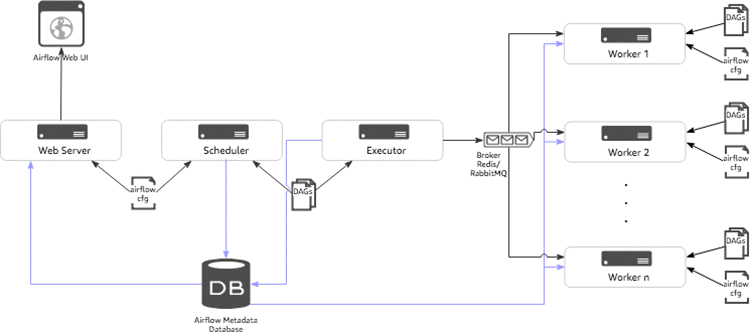Key concepts
For context around the terms used in this blog post, here are a few key concepts for Airflow:
- DAG (Directed Acyclic Graph): a workflow which glues all the tasks with inter-dependencies.
- Operator: a template for a specific type of work to be executed. For example, BashOperator represents how to execute a bash script, while PythonOperator represents how to execute a python function, etc.
- Sensor: a type of special operator which will only execute if a certain condition is met.
- Task: a parameterized instance of an operator/sensor which represents a unit of actual work to be executed.
- Plugin: an extension to allow users to easily extend Airflow with various custom hooks, operators, sensors, macros, and web views.
- Pools: concurrency limit configuration for a set of Airflow tasks.
- Connections to define any external DB, FTP etc. connection’s authentication.
- Variables to store and retrieve arbitrary content or settings as a simple key value.
- XCom to share keys/values between independent tasks.
- Pools to limit the execution parallelism on arbitrary sets of tasks.
- Hooks to reach external platforms and databases.

Figure 3.2 Screenshots from the Airflow UI, Representing the example workflow DAG. Top Subpanel: The Graph View of the DagRun for Jan. 25th. Dark green nodes indicate TaskInstances with “success” states. The light green node depicts a TaskInstance in the “running” state. Bottom Subpanel: The Tree View of the example_workflow DAG. The main components of Airflow are highlighted in screenshot, including Sensors, Operators, Tasks, DagRuns, and TaskInstances. DagRuns are represented as columns in the graph view — the DagRun for Jan. 25th is outlined in cyan. Each square in the graph view represents a TaskInstance — the TaskInstance for the (“running”) perform_currency_conversion task on Jan. 25th is outlined in blue.
Airflow architecture
The following diagram shows the typical components of Airflow architecture.

- Scheduler: The scheduler is a persistent service that monitors DAGs and tasks, and triggers the task instances whose dependencies have been met. The scheduler is responsible for invoking the executor defined in the Airflow configuration.
- Executor: Executors are the mechanism by which task instances get to run. Airflow by default provides different types of executors, and you can define custom executors, such as a Kubernetes executor.
- Broker: The broker queues the messages (task requests to be executed) and acts as a communicator between the executor and the workers.
- Workers: The actual nodes where tasks are executed and that return the result of the task.
- Web server: A webserver to render the Airflow UI.
- Configuration file: Configure settings such as executor to use, Airflow metadata database connections, DAG, and repository location. You can also define concurrency and parallelism limits, etc.
- Metadata database: Database to store all the metadata related to the DAGS, DAG runs, tasks, variables, and connections.